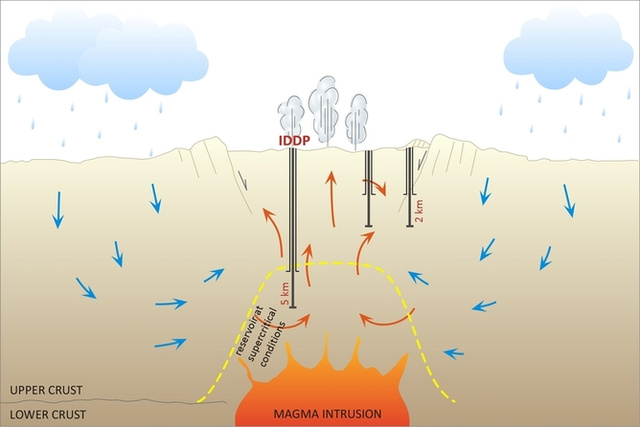It looks like you're using an Ad Blocker.
Please white-list or disable AboveTopSecret.com in your ad-blocking tool.
Thank you.
Some features of ATS will be disabled while you continue to use an ad-blocker.
4
share:
In 2009, a borehole drilled at Krafla (a caldera in northeast Iceland) as part of the Icelandic Deep Drilling Project (IDDP) unexpectedly penetrated into magma (molten rock) at only 2,100 meters (6,890 feet) depth, with a temperature of 900-1000 °C. The borehole, IDDP-1, was the first in a series of wells being drilled by the IDDP in Iceland in the search for high-temperature geothermal resources. The January 2014 issue of the international journal Geothermics is dedicated to scientific and engineering results arising from that unusual occurrence.
The issue is edited by Wilfred Elders, a professor emeritus of geology at the University of California, Riverside, who also co-authored three of the research papers in the special issue with Icelandic colleagues.
Drilling into magma is a very rare occurrence anywhere in the world and this is only the second known instance, the first one, in 2007, being in Hawaii. The IDDP, in cooperation with Iceland’s National Power Company, the operator of the Krafla geothermal power plant, decided to investigate the hole further and bear part of the substantial costs involved. In the future, the success of this drilling and research project could lead to a revolution in the energy efficiency of high-temperature geothermal areas worldwide.

The IDDP is a collaboration of three energy companies—HS Energy Ltd., National Power Company and Reykjavik Energy—and a government agency, the National Energy Authority of Iceland. It will drill the next borehole, IDDP-2, in southwest Iceland at Reykjanes in 2014-2015. From the onset, international collaboration has been important to the project, and in particular a consortium of US scientists, coordinated by Elders, has been very active, authoring several research papers in the special issue of Geothermics.
greencarcongress
io9
I believe this is the type of energy ventures that should be invested in. Once facilities have been constructed the return on such endeavours go far beyond what fossil fuels have to offer. Of course drilling into magma should have some risks but not as risky as radiation. This is one case where I say drill baby drill.
reply to post by Grimpachi
This is one case where I say drill baby drill.
It can also be used for saving the world.
www.imdb.com...
This is one case where I say drill baby drill.
It can also be used for saving the world.
www.imdb.com...
reply to post by Phage
And here I thought no one had any interest in this.
Am I wrong in thinking that if we taped this on a wide scale it could power the entire US at least until Yellowstone explodes.
After that honestly will would any power source be reliable or accessible?
On another note would it be possible to drill Yellowstone to release some of the pressure?
And here I thought no one had any interest in this.
Am I wrong in thinking that if we taped this on a wide scale it could power the entire US at least until Yellowstone explodes.
After that honestly will would any power source be reliable or accessible?
On another note would it be possible to drill Yellowstone to release some of the pressure?
reply to post by Grimpachi
It really amounts to enhanced geothermal.
I think it's applicability would depend on how deep you have to go to find magma. In Iceland and Hawaii it's apparently relatively close to the surface. The deeper you have to go the more difficult energy extraction would be.
It really amounts to enhanced geothermal.
I think it's applicability would depend on how deep you have to go to find magma. In Iceland and Hawaii it's apparently relatively close to the surface. The deeper you have to go the more difficult energy extraction would be.
reply to post by Grimpachi
What if they took too much heat and it caused a cooling of the magma to such an extent that it caused world wide earth quakes, or something even far worse like loss of magnetism?
Then again, in theory, if the right amount were siphoned off it could stabilize volcanoes and [some] earth quakes.
I'm wary of things like this. Idk
What if they took too much heat and it caused a cooling of the magma to such an extent that it caused world wide earth quakes, or something even far worse like loss of magnetism?
Then again, in theory, if the right amount were siphoned off it could stabilize volcanoes and [some] earth quakes.
I'm wary of things like this. Idk
new topics
-
Let's talk planes.
General Chit Chat: 7 hours ago -
January 6th report shows disturbing trend (nobody is shocked)
US Political Madness: 9 hours ago -
Inexplicable military simulation - virtual reality showdown in the night..
The Gray Area: 9 hours ago -
The Truth about Migrant Crime in Britain.
Social Issues and Civil Unrest: 10 hours ago
top topics
-
Trudeau Resigns! Breaking
Mainstream News: 12 hours ago, 26 flags -
January 6th report shows disturbing trend (nobody is shocked)
US Political Madness: 9 hours ago, 20 flags -
Live updates: Congress meets to certify Trump's presidential election victory
US Political Madness: 13 hours ago, 12 flags -
The Truth about Migrant Crime in Britain.
Social Issues and Civil Unrest: 10 hours ago, 10 flags -
Gravitic Propulsion--What IF the US and China Really Have it?
General Conspiracies: 14 hours ago, 9 flags -
Let's talk planes.
General Chit Chat: 7 hours ago, 5 flags -
Greatest thing you ever got, or bought?
General Chit Chat: 14 hours ago, 4 flags -
Inexplicable military simulation - virtual reality showdown in the night..
The Gray Area: 9 hours ago, 2 flags
4
